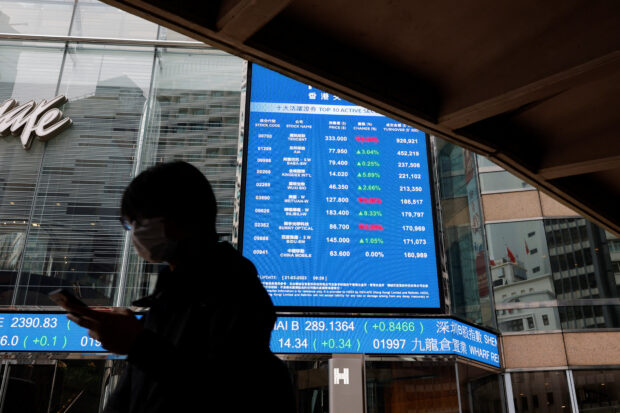
A woman walks past a screen displaying the Hang Seng Index at Central district, in Hong Kong, China March 21, 2023. REUTERS/Tyrone Siu/File photo
SYDNEY – Asian shares fell and the dollar was firm on Monday as investors looked ahead to policy meetings from the Federal Reserve, the Bank of Japan and other central banks this week.
Europe is set for a subdued open, with EUROSTOXX 50 futures off 0.1 percent. S&P 500 futures advanced 0.2 percent while Nasdaq futures edged up 0.1 percent.
Oil prices hit fresh 10-month peaks, further stoking inflationary pressures. U.S. West Texas Intermediate crude futures gained 0.8 percent to $91.52, their highest level since November, while Brent crude futures rose 0.7 percent to $94.55 per barrel.
Sentiment in Asia improved recently after news of more policy support from Beijing and better-than-expected Chinese data add to signs the slowdown in world’s second largest economy could have past it worst.
READ: China August industrial output, retail sales growth beat expectations
However, the stress in the property sector persisted, with the fear that it is spreading to the financial system. Troubled Chinese trust firm Zhongrong International Trust Co said it was unable to make payments on some trust products on time.
This week, global central banks will take center stage, with five of those overseeing the 10 most heavily traded currencies – including the U.S. Federal Reserve – holding rate-setting meetings, plus a swathe of emerging market ones as well.
Markets are fully priced for a pause from the Fed on Wednesday, so the focus will be on the updated economic and rates projections, as well as what Chair Jerome Powell says about the future. They see about 80 basis points of cuts next year.
READ: Traders bet Fed rate hikes are over, cuts to start in 2024
“In theory, the FOMC meeting should be a low-volatility affair, but it is a risk that needs to be managed,” said Chris Weston, head of research at Pepperstone.
“We should see the median projection for the 2023 fed funds rate remaining at 5.6 percent, offering the bank the flexibility to hike again in November, should the data warrant it.”
Weston added that if the Fed revises up the rate projections for 2024, that would see rate cuts being priced out, resulting in renewed interests in the U.S. dollar and downward pressure on shares.
On Thursday, Bank of England is tipped to hike for the 15th time and take benchmark borrowing costs to 5.5 percent, while Sweden’s Riksbank is seen hiking by 25 basis points to 4 percent.
Bank of Japan is the key risk event on Friday. Markets are looking for any signs that the BOJ could be moving away from its ultra-loose policy faster than previously thought, after recent comments by Governor Kazuo Ueda sent yields much higher.
Last Friday, Wall Street ended sharply lower as U.S. industrial labor action weighed on auto shares and chipmakers dropped on concerns about weak consumer demand. Rising Treasury yields also pressured Amazon and other megacap growth companies.
Cash Treasuries were not traded in Asia with Tokyo shut. Treasury yields edged higher on Friday, with the two-year above the 5 percent threshold, as futures price in higher rates for longer ahead of a the Fed’s policy meeting this week.
In the currency markets, the U.S. dollar was still standing strong near its six month top at 105.23 against a basket of major currencies.
The euro recovered 0.1 percent to $1.0068 in early Asia trade, after slumping to a 3-1/2 month low of $1.0629 last week as the European Central Bank signaled its rate hikes could be over.
Oil prices were higher on Monday, after hitting 10 month tops last Friday, stoking inflationary pressures. Brent crude futures rose 0.1 percent at $94.01 per barrel and U.S. West Texas Intermediate crude futures were up 0.2 percent at $90.97.
The gold price was flat at $1,923.33 per ounce.